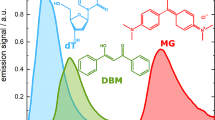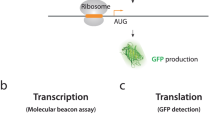Abstract
For pharmacological and toxicological studies on the effect of drugs on transcriptional processes the basic fluctuation in activity during a 24-h period must be known.
We have measured the activity of nuclear and mitochondrial DNA-dependent RNA polymerases in cell fractions from mice kept under defined dark/light and feeding schedules. The following results have been obtained:
-
1.
Circadian variations in the activity of RNA polymerases are especially pronounced in the nuclei of liver tissue. These changes depend predominantly on feeding habits and they are comparatively independent of the dark/light schedule. A maximum in the activity of nuclear DNA dependent RNA polymerases can be observed shortly after the beginning of the feeding period.
-
2.
The nuclei isolated from other tissues, such as brain, kidney or embryos during the late stage of embryogenesis show considerably smaller, if any, fluctuations in connection with the feeding habits. These tissues seem to be especially suitable for pharmacological or toxicological studies on transcriptional processes.
-
3.
While both nuclear DNA-dependent RNA polymerases show a strong dependence on the feeding habits no obvious circadian variations can be observed in the activity of the DNA-dependent RNA polymerase localized in the mitochondrial fractions of the same tissue. The regulation of these polymerases in different cell compartments apparently occurs quite independently. The conclusions for the design of experiments on induction processes occurring in liver tissues, drawn from the results presented, are discussed.
Zusammenfassung
Für pharmakologische und toxikologische Untersuchunge über die Wirkung von Pharmaka auf Transcriptionsprozesse müssen die tageszeitlichen Schwankungen in der Aktivität der zu untersuchenden Reaktion bekannt sein.
Wir haben die Aktivität von nuclearen und mitochondrialen DNA-abhängigen RNA-Polymerasen in Zellfraktionen von Mäusen gemessen, die nach definierten „Tag/Nacht”- und Fütterungsplänen gehalten wurden. Folgende Ergebnisse wurden erzielt:
-
1.
Circadiane Variationen in der Aktivität von RNA-Polymerasen sind besonders ausgeprägt in den Zellkernen von Lebergewebe. Diese Veränderungen hängen überwiegend von der Nahrungsaufnahme ab, und sie sind vergleichsweise unabhängig vom Tag/Nacht-Rhythmus. Ein Maximum in der Aktivität der nuclearen DNA-abhängigen RNA-Polymerasen kann kurz nach dem Beginn der Fütterungsperiode beobachtet werden.
-
2.
In den Zellkernen aus anderen Geweben wie Gehirn, Niere oder Embryonen während der späten Embryogenese treten, wenn überhaupt, beträchtlich geringere Schwankungen in Verbindung mit der Nahrungsaufnahme auf. Diese Gewebe scheinen für pharmakologische oder toxikologische Untersuchungen von Transcriptionsprozessen besonders geeignet zu sein.
-
3.
Während beide nuclearen DNA-abhängigen RNA-Polymerasen eine starke Abhängigkeit von der Nahrungsaufnahme zeigen, konnten keine offensichtlichen circadianen Variationen in der Aktivität von DNA-abhängiger RNA-Polymerase aus Mitochondrien-Fraktionen des gleichen Gewebes beobachtet werden. Die Regulation der Polymerasen in verschiedenen Zellkompartments erfolgt offenbar ganz unabhängig.
Die Schlüsse, die aus den vorgelegten Ergebnissen für die Planung von Experimenten über Induktionsprozesse in Lebergeweben gezogen werden können, werden diskutiert.
Similar content being viewed by others
References
Barbiroli, B., Moruzzi, M. S., Monti, M. G., Tadolini, B.: Diurnal rhythmicity of mammalian DNA-dependent RNA polymerase activities I and II: Dependence on food intake. Biochem. biophys. Res. Commun. 54, 62–68 (1973)
Barnum, C. P., Jardetzky, C. D., Halberg, F.: Time relations among metabolic and morphologic 24-hour changes in mouse liver. Amer. J. Physiol. 195, 301–310 (1958)
Blatti, S. P., Ingles, C. J., Lindell, T. J., Morris, P. W., Weaver, R. F., Weinberg, F., Rutter, W. J.: Structure and regulatory properties of eukaryotic RNA polymerase. Cold Spr. Harb. Symp. quant. Biol. 35, 649–657 (1970)
Blobel, G., Potter, V. R.: Nuclei from rat liver: isolation method that combines purity with high yield. Science 154, 1662–1665 (1966)
Burton, K.: A study of the conditions and mechanism of the reaction for the colorimetric estimation of deoxyribosenucleic acid. Biochem. J. 62, 315–323 (1956)
Dallman, P. R.: Malnutrition: incorporation of thymidine-3H into nuclear and mitochondrial DNA. J. Cell Biol. 51, 549–553 (1971)
Juhasz, P. P., Benecke, B. J., Seifart, K. H.: Inhibition of RNA polymerases from rat liver by the semi-synthetic rifampicin derivatives. FEBS Lett. 27, 30–34 (1972)
Meilhac, M., Tysper, Z., Chambon, P.: Animal DNA-dependent RNA polymerase. 4. Studies on inhibition by rifamycin derivatives. Europ. J. Biochem. 28, 291–300 (1972)
Neubert, D., Gregg, C. T., Bass, R., Merker, H.-J.: Occurrence and possible functions of mitochondrial DNA in animal development. In: The biochemistry of animal development, Vol. III (R. Weber, Ed.), pp. 387–464. New York-San Francisco-London: Academic Press 1975
Neubert, D., Helge, H., Bass, R.: Einbau von Thymidin in die Deoxyribonucleinsäure von Mitochondrien. Naunyn-Schmiedebergs Arch. exp. Path. Pharmak. 252, 258–268 (1965)
Neubert, D., Köhler, E.: Comparative studies on nucleic acid metabolism during mammalian embryonic development and during proliferation of other tissues induced by hormones or drugs. Proc. 4th Internat. Congr. Pharmacol. Basel 1969, IV, pp. 307–317. Basel-Stuttgart: Schwabe 1969
Potter, V. R., Baril, E. F., Watanabe, M., Whittle, E. D.: Systematic oscillations in metabolic functions in liver from rats adapted to controlled feeding schedules. Fed. Proc. 27, 1238–1245 (1968)
Quagliarotti, G., Hidvegi, E., Wikman, J., Busch, H.: Comparative hybridizations of nucleolar and ribosomal ribonucleic acid with nucleolar desoxyribonucleic acid. J. biol. Chem. 245, 1962–1969 (1970)
Roeder, R. G., Rutter, W. J.: Multiple forms of DNA-dependent RNA polymerase in eukaryotic organisms. Nature (Lond.) 224, 234–237 (1969)
Steinhart, W. L.: Diurnal rhythmicity in template activity of mouse liver chromatin. Biochim. biophys. Acta (Amst.) 228, 301–305 (1971)
Watanabe, M., Potter, V. R., Pitot, H. C.: Systematic oscillations in tyrosine transaminase and other metabolic functions in liver of normal and adrenalectomized rats on controlled feeding schedules. J. Nutrition 95, 207–227 (1968)
Author information
Authors and Affiliations
Additional information
Read at the Symposium “Relevance of Chronobiology for Toxicology and Pharmacology” held at the 16th Spring Meeting of the Deutsche Pharmakologische Gesellschaft, Section: Toxicology, March 6, 1975, Mainz
Rights and permissions
About this article
Cite this article
Neubert, D., Rautenberg, M. Circadian fluctuations in the activity of DNA-dependent RNA polymerases I and II in the nuclei isolated from mouse tissues and the significance for pharmacological and toxicological studies on transcription. Arch. Toxicol. 36, 217–234 (1976). https://doi.org/10.1007/BF00340530
Received:
Issue Date:
DOI: https://doi.org/10.1007/BF00340530




